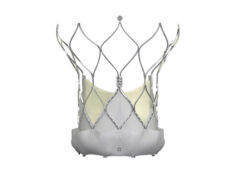
Ravi S Hira (Section of Cardiology, University of Washington, Seattle, USA) and others report in JAMA Cardiology that 9.5% of US transcatheter aortic valve implantation (TAVI) procedures are performed off-label. However, they note that the rate of one-year mortality associated with these procedures is similar to that of on-label procedures.
Hira et al comment that because of “limited proof of efficacy” TAVI is not recommended for patients at low surgical risk, or with known bicuspid aortic valve, severe mitral regurgitation, moderate aortic stenosis, severe aortic regurgitation, or with subaortic stenosis. Therefore, the use of TAVI in such patients is considered “off label” but, according to the authors, this does not mean that the procedure is “ineffective” or “inappropriate” for these patients. They add that an -abel device can sometimes be appropriate if there is a lack of alternative options for a patient because of comorbidities (ie. patients with aortic stenosis who are at high or extremely high surgical risk). “Understanding patterns of off-label TAVI use in the USA and its associated cardiovascular outcomes could help determine the best ways to explore and perhaps expand this therapy,” Hira et al write.
In their study, to assess the prevalence of off-label TAVI and its associated outcomes, the authors reviewed data from the Society of Thoracic Surgeons (STS) and American College of Cardiology (ACC) Transcatheter Valve Therapy (TVT) registry and identified 23,847 patients who underwent TAVI between November 2011 and September 2014. Of these, 9.5% (2,272) had undergone an off-label procedure. Hira et al state: “The quarterly rate of off-label TAVI increased from 2.9% in 2011 to 7.6% in 2014 with a significant decrease in overall off-label TAVI use after the first quarter (p<0.01).” They add that around three quarters (75.7%) of the off-labels procedures were so classified because of the presence of aortic and/or mitral regurgitation.
Overall, for both on- and off-label procedures, the implant success rate was 92.9%. However, the rate of in-hospital mortality was higher in the off-label group: 6.3% vs. 4.7% for the on-label group (p=0.001). The rates of cardiac arrest, transient ischaemic attack, and moderate or severe paravalvular leak were all significantly higher in the off-label group but there were no significant between group differences in the rate of postprocedural myocardial infarction, stroke, Valve Academic Research Consortium major bleeding or permanent pacemaker implantation.
Following covariate adjustment, 30-day mortality was significantly higher in the off-label group (8.5% vs. 6.1% for the on-label group; p<0.02). However, one-year mortality was similar between groups. The authors observe: “In-hospital, 30-day, and one-year mortality was highest among patients with severe mitral regurgitation as the only off-label indication.” They add: “Although we did not compare the efficacy or safety of TAVI with that of surgical aortic valve replacement or medical therapy with off-label indications, our findings suggest that TAVI is a therapeutic option with acceptable results at one year and may be beneficial for some of these patients who have inoperable conditions or are high-risk operative candidates.”
Furthermore, they found that there was “wide variation” in off-label use among hospitals in the study, with hospitals that were in the highest tertile of off-label use having a longer mean duration in the TVT registry than those hospitals in the lowest tertile. Hira et al comment that this finding suggests that “experienced sites and operators are expanding their use of TAVI to patients who would not have been routinely considered candidates at the beginning stages of site development”.
Concluding, the authors write that the findings of their study “reinforce the continued need for additional research on the safety and efficacy of TAVI in specific patient cohorts with off-label indications for whom surgical aortic valve replacement would be considered high-risk or a prohibitive risk.”
Hira told Cardiovascular News: “I think the consideration of off-label TAVI should be a heart team decision that is made in the best interest of the patient after considering the pros and cons of surgery or medical therapy vs. TAVI. Also, it is important to recognize that the best option for many of these patients may be referral to higher volume centres with more experience in performance of TAVI in patients with these off-label indications.”










